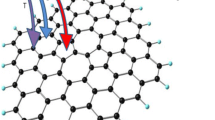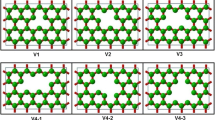Abstract
A first principle calculation has been performed to explore the magnetism in nano structures of graphene due to vacancies in carbon lattice and functionalized (hydrogenated) graphene due to vacancies in hydrogen lattice. Nano structures containing 50C atoms (5 × 5 × 1 super cell) have been considered. Using the method of numeric localized atomic orbitals, pseudo potentials and density functional theory, spin polarised electron density of states have been calculated and C–C bond lengths, C–C–C and H–C–C bond angles, formation energy and magnetic moment have been obtained. It has been found that due to defects (vacancies) in carbon lattice of pristine graphene, nano structure develops magnetic moment, which varies with the size of defect. A nano structure with four contiguous vacancies is found to have a magnetic moment of 2.0 µB. The nano structures of hydrogenated graphene also develop magnetic moment due to vacancies in hydrogen lattice , which varies with number and position of vacancies. A nano structure with half hydrogenated graphene obtained by removing all the hydrogen atoms from one side of graphane, (alternate vacancies in hydrogen lattice 50C25H atoms, graphone) is found to develop a large magnetic moment of 25.0 µB.





Similar content being viewed by others
References
K S Novoselov et al. Science 306 666 (2004)
D S L Abergel, V Apalkov, J Berashevich, V Ziegler and T Chakraborty Adv. Phys. 59 261 (2010)
S Mitra et al. Indian J. Phys. 85 649 (2011)
R K Pandyan, S Seenithurai and M Mahendran Indian J. Phys. 86 677 (2012)
C Bai, J Wang, G Yang and Y Yang Indian J. Phys. 87 133 (2013)
H Goudarzi, N Aghamirli and S Anvarian Indian J. Phys. 87 1105 (2013)
R Majidi and A R Karami Indian J. Phys. 88 483 (2014)
J O Sofo, A S Chaudhari and G D Barber Phys. Rev. B. 75 153401 (2007)
D C Elias et al. Science 323 610 (2009)
J Zhou, Q Wang, Q Sun, X S Chen, Y Kawazoe and P Jena Nano Lett. 9 3867 (2009)
H Lee, Y W Son, N Park, S Han and J Yu Phys. Rev. B 72 174431 (2005)
Y Zhang, S Talapatra, S Kar, R Vajtai, S K Nayak and P M Ajayan Phys. Rev. Lett. 99 107201 (2007)
Y Wang et al. Nano Lett. 9 220 (2009)
J J Palacios, J Fernández-Rossier and L Brey Phys. Rev. B 77 195428 (2008)
J Berashevich and T Chakraborty Nanotechnology 21 355201 (2010)
NM R Peres, M A N Araújo and D Bozi Phys. Rev. B 70 195122 (2004)
D W Boukhvalov, M I Katsnelson and A I Lichtenstein Phys. Rev. B 77 035427 (2008)
H Şahin, C Ataca and S Ciraci Appl. Phys. Lett. 95 222510 (2009)
N Kumar, J D Sharma and P K Ahluwalia Emerging Paradigms of Nanotechnology (IN:Pearson) (ed.) R C Sobti et al. p 806 (2013)
P Esquinazi, D Spemann, R Höhne, A Setzer, K H Han and T Butz Phys. Rev. Lett. 91 227201 (2003)
P Esquinazi et al. Phys. Rev. B 66 024429 (2002)
A V Rode et al. Phys. Rev. B 70 054407 (2004)
S Talapatra et al. Phys. Rev. Lett. 91 097201 (2003)
T L Makarova Studies of High-Temperature Superconductivity (New York: NOVA Science) p 107 (2003)
T L Makarova Semiconductors 38 615 (2004)
Y Yazyev and L Helm Phys. Rev. B 75 125408 (2007)
P Chandrachud, S B Pujari, S Haldar, B Sanyal and D G Kanhere J. Phys. Condens. Matter 22 465502 (2010)
J D Sharma, P K Ahluwalia and N Kumar AIP Conf. Proc. 1393 321 (2011)
N Kumar, J D Sharma, A Kumar and P K Ahluwalia AIP Conf. Proc. 1512 192 (2013)
J M Soler et al. J. Phys. Condens. Matter 14 2745 (2002)
User’s Guide, SIESTA 3.2, http://departments.icmab.es/leem/siesta/(Last accessed on 21st May, 2014)
Acknowledgments
We acknowledge SIESTA team for providing the code.
Author information
Authors and Affiliations
Corresponding author
Rights and permissions
About this article
Cite this article
Kumar, N., Sharma, M., Sharma, J.D. et al. Study of magnetism in nano structures of graphene and functionalized graphene: a first principle study. Indian J Phys 89, 143–150 (2015). https://doi.org/10.1007/s12648-014-0526-2
Received:
Accepted:
Published:
Issue Date:
DOI: https://doi.org/10.1007/s12648-014-0526-2




